Archived Storm Damage Blog Posts
Understanding the Impact of Storm Surge on Coastal Properties
9/11/2024 (Permalink)
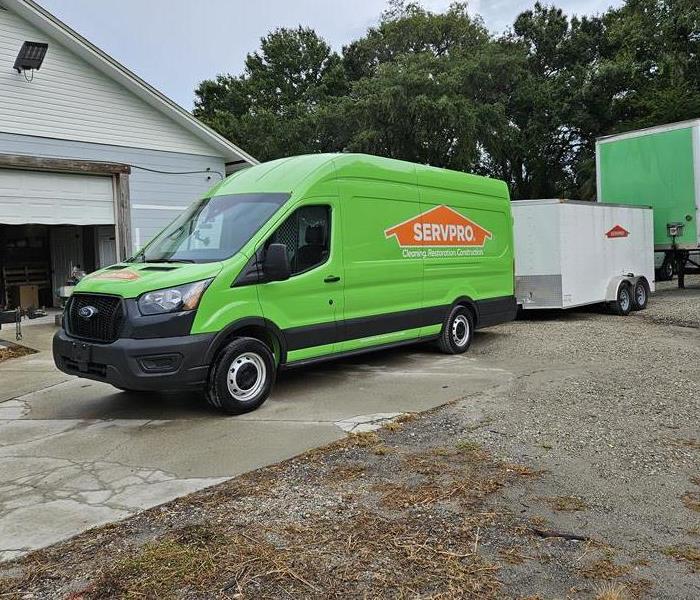 Remember, SERVPRO can help you navigate through the storm and restore your peace of mind.
Remember, SERVPRO can help you navigate through the storm and restore your peace of mind.
Living along the coast comes with the beauty of ocean views and the tranquility of seaside living. However, coastal properties are particularly vulnerable to the devastating effects of storm surge. At SERVPRO®, we understand the significant impact storm surge can have on your property and are here to provide insights on how to prepare and protect your coastal home.
What is Storm Surge?
Storm surge is an abnormal rise in sea level caused by a storm, typically a hurricane or tropical storm, pushing seawater onto the shore. Unlike regular tides, storm surges can lead to rapid and extreme flooding, causing substantial damage to coastal properties. The severity of storm surge depends on various factors, including storm intensity, speed, size, and the coastal topography.
Impact on Coastal Properties
The impact of storm surge on coastal properties can be catastrophic. As water levels rise, homes and businesses along the coast face the risk of severe flooding, structural damage, and erosion. Floodwaters can inundate basements, ground floors, and even higher levels, depending on the surge's height. This influx of water can compromise the integrity of buildings, leading to costly repairs and extended recovery times.
Additionally, storm surge can erode shorelines and undermine the foundations of structures near the coast. This erosion not only affects the stability of buildings but also reduces the natural barriers that protect properties from future storms. The force of the surge can also carry debris, further damaging properties and creating hazardous conditions.
Preparing for Storm Surge
Preparation is key to mitigating the impact of storm surge on coastal properties. Here are some essential steps to protect your home or business:
- Elevate Your Property: If feasible, elevate your home or business above the base flood elevation. This can significantly reduce the risk of flood damage during a storm surge.
- Install Storm Shutters: Protect windows and doors with storm shutters to prevent water from entering your property during a surge.
- Seal Gaps and Cracks: Ensure that all gaps, cracks, and openings in your property’s foundation and walls are sealed to prevent water intrusion.
- Create a Flood Barrier: Use sandbags or other flood barriers around your property to redirect floodwaters away from your home or business.
- Secure Outdoor Items: Remove or secure outdoor furniture, equipment, and other items that can become projectiles during a storm surge.
Recovery and Restoration
In the aftermath of a storm surge, swift action is crucial to minimize further damage and begin the restoration process. At SERVPRO, we specialize in storm damage restoration and are equipped to handle the unique challenges posed by storm surge. Our team of professionals will assess the damage, extract floodwaters, and restore your property to its pre-storm condition efficiently and effectively.
Understanding the impact of storm surge on coastal properties is essential for homeowners and business owners in coastal areas. By taking proactive measures to prepare and protect your property, you can reduce the risk of damage and ensure a quicker recovery. Remember, SERVPRO can help you navigate through the storm and restore your peace of mind.
Navigating Water Damage After a Southeastern Storm
5/15/2024 (Permalink)
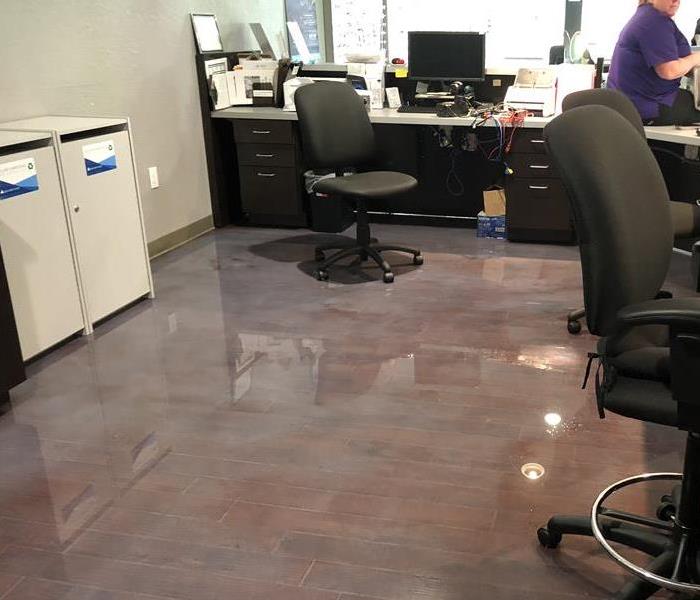 Dealing with water damage after a storm can be challenging, but with the right approach, you can effectively restore your property.
Dealing with water damage after a storm can be challenging, but with the right approach, you can effectively restore your property.
Water damage is a common aftermath of storms in Florida, where heavy rainfall and flooding are frequent occurrences. Dealing with water damage can be overwhelming, but understanding the necessary steps can help homeowners navigate the process effectively. Here's a comprehensive guide to dealing with water damage after a storm:
1. Safety First
Before attempting any cleanup or restoration efforts, prioritize safety. Turn off the power supply to affected areas if it's safe to do so, and avoid contact with standing water, as it may contain harmful contaminants or pose electrical hazards. Wear protective gear, such as gloves and boots, to minimize exposure to potential hazards.
2. Assess the Damage
Once it's safe to do so, assess the extent of the water damage in your home. Check for visible signs of water intrusion, such as soaked carpets, water stains on walls or ceilings, and warped or damaged flooring. Take photos or videos of the damage for insurance purposes and documentation.
3. Remove Standing Water
Promptly remove any standing water from your home to prevent further damage and mold growth. Use a wet/dry vacuum, mops, or towels to soak up excess water. If the water level is too high or if there's significant flooding, consider seeking professional assistance from water damage restoration experts like SERVPRO®.
4. Dry Out the Affected Areas
Thoroughly dry out the affected areas using fans, dehumidifiers, and natural ventilation. Open windows and doors to promote air circulation, and use fans to expedite the drying process. Pay special attention to hidden or hard-to-reach areas, such as behind walls or under flooring, as moisture trapped in these areas can lead to mold growth and structural damage.
5. Clean and Disinfect
After removing standing water and drying out the affected areas, thoroughly clean and disinfect all surfaces to prevent mold and bacteria growth. Use a mild detergent or disinfectant solution to clean walls, floors, and other surfaces that came into contact with floodwater. Pay attention to furniture, appliances, and personal belongings that may also require cleaning and disinfection.
6. Monitor for Mold
Keep a close eye on your home for any signs of mold growth in the days and weeks following the water damage. Mold thrives in damp, humid environments, so it's essential to maintain proper ventilation and humidity levels to prevent mold from taking hold. If you notice any signs of mold growth, such as musty odors or visible mold growth, contact a professional mold remediation specialist like SERVPRO for assistance.
7. Work with Your Insurance Company
Finally, contact your insurance company to file a claim for the water damage and begin the claims process. Provide them with documentation of the damage, including photos, videos, and receipts for any repairs or restoration work. Work closely with your insurance adjuster and restoration professionals to ensure that your home is restored to its pre-damage condition.
Dealing with water damage after a storm can be challenging, but with the right approach and assistance, homeowners can effectively restore their homes and minimize further damage. By following these steps and working with experienced professionals like SERVPRO of NE Hillsborough/Plant City, homeowners can navigate the process of water damage restoration with confidence and peace of mind.
Tips to Protect Against Storm Damage
1/8/2024 (Permalink)
Electronics are integral parts of our daily lives, yet they are vulnerable to damage during storms. Lightning strikes, power surges, and water exposure pose significant risks to our valuable devices. We've compiled a list of tips to protect your electronics during storms.
Invest in Surge Protectors
Surge protectors act as the first line of defense against electrical surges caused by lightning strikes or power fluctuations. Use high-quality surge protectors for your electronic devices, including computers, TVs, gaming consoles, and other valuable equipment. Consider whole-house surge protection systems for added security.
Unplug During Storms
Before a storm hits, unplug electronic devices from power outlets. This simple step can prevent damage caused by power surges or lightning strikes. Keeping devices disconnected from power sources eliminates the risk of electrical surges damaging sensitive circuitry.
Utilize Battery Backup Systems
Invest in uninterruptible power supply units or battery backup systems for critical electronics like computers and home entertainment systems. These devices provide temporary power during outages, giving you time to properly shut down equipment and prevent data loss or hardware damage.
Create a Safe Storage Space
Designate a safe area within your home to store electronics during storms. Keep them away from windows and doors to minimize exposure to potential water damage. Additionally, consider elevated storage to protect against flooding.
Implement Insurance Coverage
Review your insurance policy to ensure adequate coverage for electronics damaged during storms. Understanding your policy's coverage for electronic devices can provide peace of mind and financial protection in case of unforeseen damage.
Backup Data Regularly
Backing up your electronic data is crucial. Use cloud storage solutions or external hard drives to regularly back up important files, documents, and media. In the event of damage or loss, having backups ensures that your valuable data remains accessible.
Post-Storm Inspection
After a storm passes, conduct a thorough inspection of your electronics. Look for signs of water damage, unusual behavior, or visible damage. If any issues are detected, refrain from powering on the devices and seek professional assistance for evaluation and restoration.
Protecting your electronics during storms requires proactive measures and thoughtful preparation. By implementing these tips, you can significantly reduce the risk of damage to your valuable devices. Remember, SERVPRO of NE Hillsborough/Plant City is here to assist you in the event of storm-related damage.
What is the Saffir-Simpson Hurricane Wind Scale?
9/17/2023 (Permalink)
Hurricanes are powerful natural disasters that can cause extensive damage to homes and properties. To better understand and prepare for these storms, it is crucial to familiarize yourself with the Saffir-Simpson Hurricane Wind Scale. Developed in 1971, this scale categorizes hurricanes based on their wind speeds and provides valuable insights into their potential impact. In this blog, we will explore the Saffir-Simpson Hurricane Wind Scale, empowering homeowners and property owners with the knowledge to safeguard their assets and stay safe during hurricane season.
What is the Saffir-Simpson Hurricane Wind Scale?
The Saffir-Simpson Hurricane Wind Scale, commonly referred to as the Hurricane Scale, is a classification system used to categorize hurricanes based on their sustained wind speeds. The scale, ranging from Category 1 to Category 5, helps meteorologists and emergency responders assess the potential damage and impact of an approaching hurricane.
Understanding Each Category
Category 1 (74-95 mph): Hurricanes in this category are considered weak, with wind speeds that can cause minimal damage to homes, trees, and power lines. While still dangerous, preparations for a Category 1 hurricane should focus on securing loose items and preparing for possible power outages.
Category 2 (96-110 mph): Category 2 hurricanes bring stronger winds that can cause moderate damage to roofs, windows, and mobile homes. It is crucial to reinforce weak structures and secure outdoor belongings before the storm arrives.
Category 3 (111-129 mph): A Category 3 hurricane is considered a major hurricane. It can cause extensive damage to well-built homes, uproot trees, and disrupt power and water services. Evacuation may be necessary in areas prone to storm surges.
Category 4 (130-156 mph): Category 4 hurricanes are extremely dangerous and can cause severe structural damage to homes and buildings. Widespread power outages, flooding, and storm surges are expected. Evacuation orders are often issued for vulnerable coastal communities.
Category 5 (157 mph or higher): The most catastrophic hurricanes fall under Category 5. These storms cause complete roof failure, extensive damage to buildings, and significant infrastructure destruction. Residents in the path of a Category 5 hurricane must evacuate to secure locations.
Importance of Knowing the Scale
Understanding the Saffir-Simpson Hurricane Wind Scale is essential for preparedness and decision-making during hurricane season. It allows homeowners and property owners to gauge the severity of an approaching storm and take appropriate measures to protect their assets and ensure their safety.
Preparedness Measures for Each Category
Based on the category of an approaching hurricane, different levels of preparedness are required. Homeowners should stock up on emergency supplies, create a family evacuation plan, and reinforce their properties based on the anticipated wind strength.
The Saffir-Simpson Hurricane Wind Scale is a valuable tool for homeowners and property owners to comprehend the potential impact of an approaching hurricane. By understanding the differences between each category, individuals can make informed decisions, prepare their homes, and prioritize safety measures accordingly. Familiarize yourself with the scale, stay informed through weather updates, and be proactive in your hurricane preparedness efforts. By taking these steps, you can better protect your home, loved ones, and property during the unpredictable hurricane season.
What Not to Do After a Flood: Essential Guidelines for Post-Flood Recovery
7/10/2023 (Permalink)
Dealing with the aftermath of a flood can be overwhelming and challenging. It's important to approach the situation with caution and make informed decisions to ensure your safety and the proper recovery of your property. In this blog, we will discuss what not to do after a flood, providing you with essential guidelines to avoid common pitfalls and minimize further damage during the recovery process.
Proper Safety Precautions
Do not walk or wade through floodwaters without proper protective gear. The water may contain contaminants, sharp objects, or hidden hazards. Avoid entering flooded basements or structures until professionals have deemed them safe. Structural integrity may be compromised, and electrical and gas systems could pose serious risks.
Delay Contacting Relevant Authorities and Insurance
Do not delay contacting your insurance provider to initiate the claim process. Document the damage and keep records of all communications. Report the flood to local authorities and emergency management agencies. They can provide assistance and guidance in the recovery process.
Touch Electrical Systems or Appliances without Professional Evaluation
Do not touch electrical panels, outlets, or appliances if they have been submerged or if you suspect water damage. Contact a qualified electrician to assess the situation and ensure it is safe before attempting any repairs or operations.
Dispose of Items without Proper Documentation
Avoid throwing away damaged items without proper documentation for insurance purposes. Take photographs, make a detailed inventory of damaged items, and keep receipts and invoices whenever possible.
Neglect Proper Cleaning and Disinfection
Do not overlook the importance of thorough cleaning and disinfection after a flood. Standing water and moisture can promote the growth of mold and bacteria. Follow recommended cleaning protocols and use appropriate disinfectants to mitigate.
Ignore Structural Damage and Mold Growth
Do not overlook signs of structural damage, such as cracks, warping, or shifting. Consult a professional contractor or engineer to assess the integrity of the building and make necessary repairs. Address mold growth promptly to prevent its spread. Mold can begin to develop within 24-48 hours after a flood. Seek professional mold remediation services if necessary.
Attempt Extensive Repairs without Professional Assistance
Do not attempt extensive repairs or renovations without professional guidance. Structural repairs, electrical work, and plumbing modifications should be handled by qualified contractors to ensure safety and compliance with building codes. Do not neglect your emotional well-being and the well-being of others affected by the flood. Seek support from friends, family, or counseling services to help cope with the stress and emotional toll of the situation.
Recovering from a flood requires careful consideration and adherence to proper guidelines. By knowing what not to do after a flood, you can avoid common mistakes and protect yourself, your property, and your loved ones. Remember to prioritize safety, involve professionals for assessments and repairs, document the damage for insurance purposes, and take care of your emotional well-being throughout the recovery process. With a proactive and informed approach, you can navigate the post-flood recovery effectively and restore your property to its pre-flood condition.
5 Steps to Mitigate Damage After a Storm
5/19/2022 (Permalink)
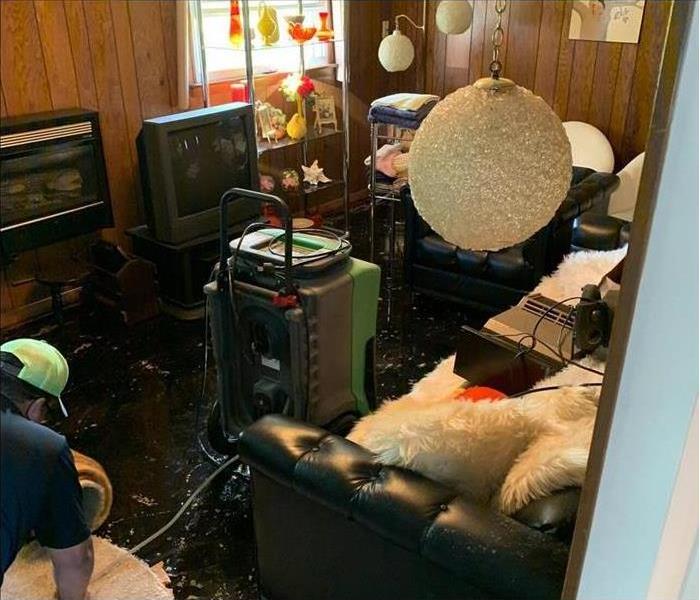 Has a storm affected your home and family? Call SERVPRO right away to help keep your family safe.
Has a storm affected your home and family? Call SERVPRO right away to help keep your family safe.
5 Steps For Storm Damage Mitigation
Storms in Plant City, FL, can happen at any time of the year, and they can cause tremendous damage. Whether it is large hail, heavy winds, pouring rain, tornadoes or high amounts of snow, you more than likely have some cleaning up to do and some repairs. The following storm tips will help to minimize damage.
1. Keep Your Family Safe
Your first priority in a storm is to make sure you and your family are in a safe place when the storm is occurring. Once the storm has passed, assess the damage of your home and stay away from broken glass, exposed nails and other sharp objects.
2. Perform Emergency Repairs as Needed
Although calling a professional residential restoration company is important to deal with major storm damage, there are some things you can do immediately after the storm before the professionals arrive. Some of the storm tips are to place plywood over broken windows or place buckets under leaks to prevent further water damage.
3. Call for Professionals to Help Repair Storm Damage
Even if you are handy around the house, it is best to rely on professionals for much of the cleanup. They have the right equipment for restoration, such as to manage flood damage to prevent mold buildup, and there are things they can find that may not be obvious to you.
4. Take Inventory of Damaged Goods
Note the structural damage as well as any damaged property inside and outside the house. Make a complete list and take pictures so you can provide proof.
5. Contact Your Insurance Company
If you have homeowner's insurance, contact your insurance company right away. They can guide you through your next steps and help you file a claim.
Dealing with a storm can be challenging. However, with these storm tips, you know what you can do to take immediate action to prevent further damage.
3 Questions To Ask About Flood Zones
5/12/2022 (Permalink)
3 Flood Zone Inquiry Questions
When large storms hit your area, you might hear neighbors talk about the different flood zones around you and how people are affected by them. If you have never been impacted by significant floods, you might be unsure what flood zones are. Here are three questions you should ask about flood zones.
1. What Is a Flood Zone?
FEMA has categorized different geographical areas of the country based on their chance of flooding and the severity of the flood. Some areas are low to moderate risk, with chances of a flood occurring every 100 to 500 years. Other areas are at higher risk, with the possibility of a flood happening anywhere from every year to every 30 years, depending on where your Valrico, FL, is located.
2. Is Your Home in a Zone?
The easiest way to know if your home is in a flood zone is to do a simple search online. Many websites have access to FEMA floodplain information and will tell you the chances that your home could flood.
If you don't feel that the floodplain map is correct for your home or surrounding area, you can reach out to FEMA and ask them to review your community. If the emergency organization finds that your home no longer fits the category they have you in, they will update their information.
3. How Do You Protect Your Home?
Living in a flood zone means that you should always be ready for the possibility of a flood every time a major storm hits. A mere half an inch of water on the floor of your home can cause catastrophic damage, so you never want to be without flood insurance.
You also want to research some flood restoration specialists in your area and keep their contact information on hand. If your home does get flooded, you'll want to contact them immediately to start the clean-up process.
Large storms might bring floods to your home, but understanding what a floodplain is and how to protect your home can take some of the fear out of a potentially scary situation.
How Can I Perform Upkeep On A Commercial Roof?
5/1/2022 (Permalink)
How Can I Maintain a Commercial Roof?
While running your business in Valrico,FL, you want to ensure that your structures are sound and in good shape. It is important to maintain them on a regular basis, particularly when facing damage from a storm that results in a roof leak. Knowing what to look for and the type of work you may need done can help you decide when to contact a professional.
Keep Gutters Clean
When gutters are unable to drain properly because of a blockage, it is possible for water or debris to cause a backup. If there is water left standing within the gutters, that can make it difficult for proper drainage to occur. Besides checking to see that the gutters are clean, it's crucial to make sure they are held down properly in case wind damage occurs.
Check Drainage Systems
Working with storm damage restoration professionals can be helpful when you have concerns about your drainage systems, both for your roof and the storm drainage on the ground. For example, if there was a flood that occurred in the area, you'll want to ensure that the storm drainage near your business is not otherwise backed up. If it is, it's imperative that the problem gets corrected so you don't experience further flooding.
Examine Hatches and Skylights
The next time you find yourself out on the roof, check for cracks, especially in any areas where there are hatches or skylights. Find out if there was any breakage due to hail or other storm elements. Cracks in these structures can lead to a roof leak, which might go undetected at first. Looking out for damage on a regular basis allows you to catch it before you need to replace your entire roof because of leaking.
Performing upkeep on your commercial roof involves checking regularly for damage. Once you spot a roof leak, it's important to get it fixed right away, so the problem doesn't spread.
SERVPRO Provides Disaster Assistance Your Business Can Count On
3/18/2022 (Permalink)
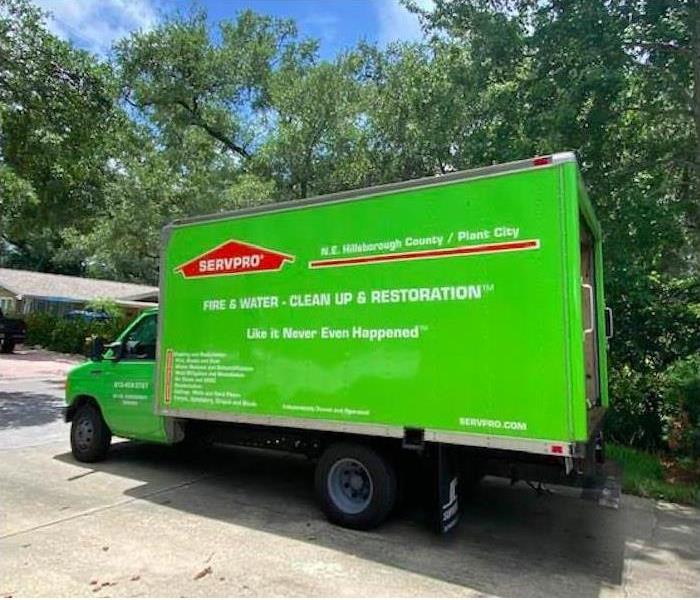 A local SERVPRO franchise can help your business recover from the worst storm damage and get it back up and running.
A local SERVPRO franchise can help your business recover from the worst storm damage and get it back up and running.
SERVPRO Offers Disaster Recovery Services You Can Rely On
When a devastating storm wreaks havoc on your business in Plant City, FL, disaster recovery hinges upon immediate storm response efforts. A local SERVPRO franchise can help your business recover from the worst storm damage and get it back up and running.
Types of Storm Damage
Severe storms can cause costly damage to your business due to:
- Broken windows and doors
- Electrical systems failures
- Destruction of furnishings and equipment
- Flooding
- Air contamination
The best way to prevent irreparable damage following a storm-related disaster is to contact a highly qualified local SERVPRO franchise whose knowledgeable personnel can rush to handle the clean-up and remediation efforts.
SERVPRO Response
When your business's survival is on the line and hinges upon immediate action following a disaster, SERVPRO's unmatched quick response time can keep you from permanently closing your doors. SERVPRO gives each franchise the support and resources it needs to acquire the most powerful and durable equipment to deep clean your business and trains its staff to coordinate every aspect of emergency storm response.
Businesses that use SERVPRO's disaster recovery services following a severe storm can rely upon a multi-pronged sanitization process that incorporates CDC and EPA-sanctioned cleaning and remediation practices.
SERVPRO Clean Is Like No Other
With over 1700 American franchises, SERVPRO continues to be the leader in disaster restoration and recovery services. Its reputation for restoring when possible and replacing when necessary ensures that businesses suffer as little disruption as possible following a severe storm.
SERVPRO training teams provide continuous support and education to field personnel, enabling them to apply powerful yet safe methods for cleaning, sanitizing and restoring your business property. Standards compliance teams select and vet preferred vendors who can reliably uphold SERVPRO's performance criteria before they can participate in storm response and other disaster recovery efforts.
When storm damage to your business leaves you wondering when you can resume operating, SERVPRO's disaster recovery services are ready to jump in to offer the help you need in Plant City, FL
Flood or Storm Damage: When is a Flood a Flood
1/13/2022 (Permalink)
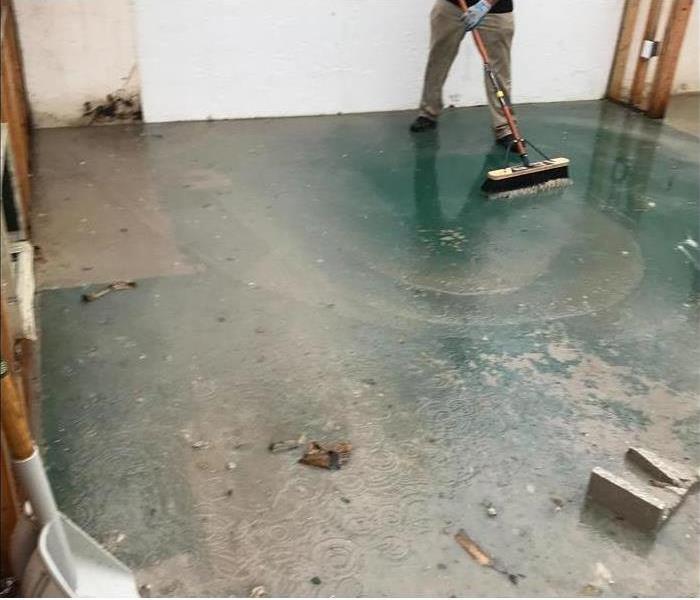 SERVPRO is your local water, flood, and fire damage restoration professional. Call SERVPRO today to learn more about how we can help! (813) 459-3767
SERVPRO is your local water, flood, and fire damage restoration professional. Call SERVPRO today to learn more about how we can help! (813) 459-3767
When Is A Flood A Flood?
Flooding is one of those issues that causes a lot of controversy around the idea of insurance coverage. While flood damage requires individual riders and sometimes special policies, storm damage is often covered under a typical business policy. Why is that, and what exactly is the difference between flood and stormwater damage? The critical issue is in the definition of flood and stormwater.
1. Flood Water
Flood water is defined by territory and natural formation. Therefore, overflowing rivers, lakes, creeks, watercourses and dams are considered floods. Water overflowing from these areas and into your building will require coverage from an individual insurance rider or policy.
2. Stormwater
Stormwater refers to water overflowing from drains due to backups or rainwater. This type of flood damage is considered damage from a storm or other humanmade issue. However, while most policies will cover this type of damage, you may require special insurance coverage for your surrounding property or possible business interruption.
3. Water Damage Overlap
There are instances where both rainwater and overflowing rivers cause flooding. In these instances, it is up to your insurer what items are covered or not, likely anything explicitly caused by rainwater and damaging your property will be covered, but this can be hard to prove.
4. Water Coverage and Recovery
The most practical thing to do is to get a flood insurance rider if you are in a moderate to high-risk flood zone. By covering multiple possibilities, you can ensure a better outcome. Call your insurer or a flood remediation specialist in the Valrico, FL, area to discuss your options further.
Flood damage is unique in that its causes vary wildly from natural occurrences to humanmade crisis but that it is not as broadly covered by insurance policies. Insurers define flood water and stormwater in different ways which may result in the necessity of multiple policies or riders.



 24/7 Emergency Service
24/7 Emergency Service




